Related Research Articles
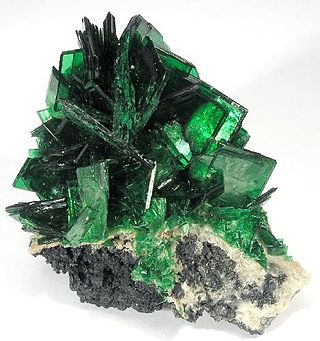
Torbernite, also known as chalcolite, is a relatively common mineral with the chemical formula Cu[(UO2)(PO4)]2(H2O)12. It is a radioactive, hydrated green copper uranyl phosphate, found in granites and other uranium-bearing deposits as a secondary mineral. The chemical formula of torbernite is similar to that of autunite in which a Cu2+ cation replaces a Ca2+ cation. Torbernite tends to dehydrate to metatorbernite with the sum formula Cu[(UO2)(PO4)]2(H2O)8.
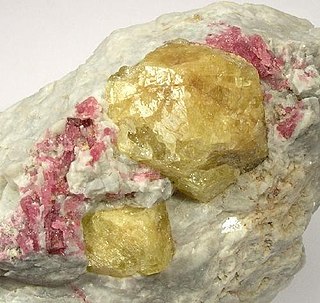
The Borate Minerals are minerals which contain a borate anion group. The borate (BO3) units may be polymerised similar to the SiO4 unit of the silicate mineral class. This results in B2O5, B3O6, B2O4 anions as well as more complex structures which include hydroxide or halogen anions. The [B(O,OH)4]− anion exists as well.
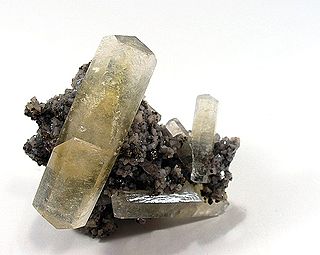
Carbonate minerals are those minerals containing the carbonate ion, CO2−
3.

Sulfosalt minerals are sulfide minerals with the general formula AmBnXp, where
Founded in 1958, the International Mineralogical Association (IMA) is an international group of 40 national societies. The goal is to promote the science of mineralogy and to standardize the nomenclature of the 5000 plus known mineral species. The IMA is affiliated with the International Union of Geological Sciences (IUGS).
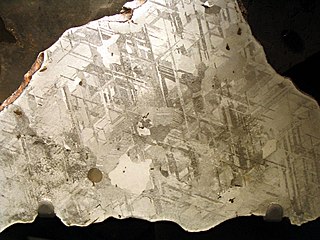
Taenite is a mineral found naturally on Earth mostly in iron meteorites. It is an alloy of iron and nickel, with a chemical formula of Fe,Ni and nickel proportions of 20% up to 65%.

Nickel–Strunz classification is a scheme for categorizing minerals based upon their chemical composition, introduced by German mineralogist Karl Hugo Strunz in his Mineralogische Tabellen (1941). The 4th and the 5th edition was also edited by Christel Tennyson (1966). It was followed by A.S. Povarennykh with a modified classification.
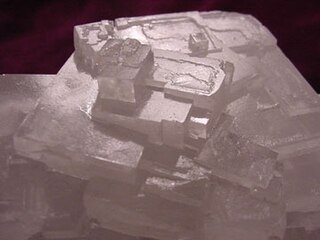
Halide minerals are those minerals with a dominant halide anion. Complex halide minerals may also have polyatomic anions.
Arsenite minerals are very rare oxygen-bearing arsenic minerals. Classical world localities where such minerals occur include the complex skarn manganese deposit at Långban (Sweden) and the polymetallic Tsumeb deposit (Namibia). The most often reported arsenite anion in minerals is the AsO33− anion, present for example in reinerite Zn3(AsO3)2. Unique diarsenite anions occur i. e. in leiteite Zn[As2O4] and paulmooreite Pb[As2O5]. More complex arsenites include schneiderhöhnite Fe2+Fe3+3[As5O13] and ludlockite PbFe3+4As10O22.

The sulfate minerals are a class of minerals that include the sulfate ion within their structure. The sulfate minerals occur commonly in primary evaporite depositional environments, as gangue minerals in hydrothermal veins and as secondary minerals in the oxidizing zone of sulfide mineral deposits. The chromate and manganate minerals have a similar structure and are often included with the sulfates in mineral classification systems.

Coloradoite, also known as mercury telluride (HgTe), is a rare telluride ore associated with metallic deposit. Gold usually occurs within tellurides, such as coloradoite, as a high-finess native metal.

Native element minerals are those elements that occur in nature in uncombined form with a distinct mineral structure. The elemental class includes metals, intermetallic compounds, alloys, metalloids, and nonmetals. The Nickel–Strunz classification system also includes the naturally occurring phosphides, silicides, nitrides, carbides, and arsenides.

Daubréelite is a rare sulfide mineral. It crystallizes with cubic symmetry and has chemical composition of Fe2+Cr3+2S4. It usually occurs as black platy aggregates.
Karl Hugo Strunz was a German mineralogist. He is best known for creating the Nickel-Strunz classification, the ninth edition of which was published together with Ernest Henry Nickel.
Georgius Agricola is considered the 'father of mineralogy'. Nicolas Steno founded the stratigraphy, the geology characterizes the rocks in each layer and the mineralogy characterizes the minerals in each rock. The chemical elements were discovered in identified minerals and with the help of the identified elements the mineral crystal structure could be described. One milestone was the discovery of the geometrical law of crystallization by René Just Haüy, a further development of the work by Nicolas Steno and Jean-Baptiste L. Romé de l'Isle. Important contributions came from some Saxon "Bergraths"/ Freiberg Mining Academy: Johann F. Henckel, Abraham Gottlob Werner and his students. Other milestones were the notion that metals are elements too and the periodic table of the elements by Dmitri Ivanovich Mendeleev. The overview of the organic bonds by Kekulé was necessary to understand the silicates, first refinements described by Bragg and Machatschki; and it was only possibly to understand a crystal structure with Dalton's atomic theory, the notion of atomic orbital and Goldschmidt's explanations. Specific gravity, streak and X-ray powder diffraction are quite specific for a Nickel-Strunz identifier. Nowadays, non-destructive electron microprobe analysis is used to get the empirical formula of a mineral. Finally, the International Zeolite Association (IZA) took care of the zeolite frameworks.
Some organic compounds are valid minerals, recognized by the CNMNC (IMA).
Joseph (Joe) Anthony Mandarino OC, FRSC was an American-Canadian mineralogist and crystallographer.

Ferronickel platinum is a very rarely occurring minerals from the mineral class of elements (including natural alloys, intermetallic compounds, carbides, nitrides, phosphides and silicides) with the chemical composition Pt2FeNi and thus is chemically seen as a natural alloy, more precisely an intermetallic compound of platinum, nickel and iron in a ratio of 2:1:1.
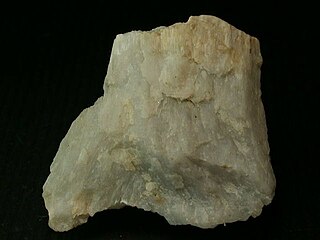
Tilleyite is a rarely occurring calcium sorosilicate mineral with formula Ca3[Si2O7]·2CaCO3. It is chemically a calcium silicate with additional carbonate ions. Tilleyite crystallizes in the monoclinic crystal system and forms only poorly developed, irregularly defined, tabular crystals and spherical grains. In its pure form it is colorless and transparent, however due to multiple refractions of light from lattice defects or polycrystalline formation, it can also appear white, with the transparency decreasing accordingly.
References
- 1 2 3 Birch, William D. (2009). "Ernest Henry Nickel" (PDF). Elements: 272. Archived from the original (PDF) on 22 March 2012. Retrieved 19 January 2013.
- ↑ "Ernest Henry Nickel" (PDF). aspo-australia.org.au. doi:10.3200/RMIN.84.1.63-65. Archived from the original (PDF) on 6 July 2011.
{{cite journal}}: Cite journal requires|journal=(help)